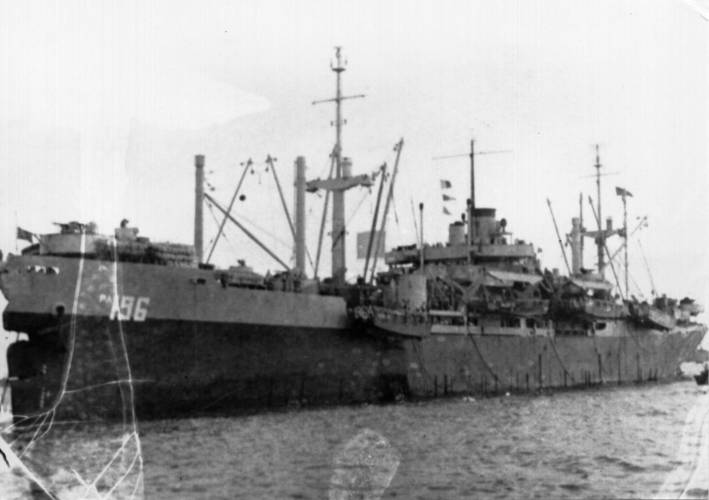
|
APA 196 USS Logan |
||||
| Click Here for USS Logan Main Page | ||||
 |
Specifications:
Displacement 6,873 t.(lt) 14,837 t.(fl)
Length 455'
Beam 62'
Speed 19 kts.
Complement 56 Officers 480 Enlisted
Troop Accommodations 86 Officers 1,475 Enlisted
Cargo Capacity 150,000 cu. ft. or 2,900 tons
Boats 2 LCM, 12 LCVP, 3 LCPU
Armament one 5"/38 dual-purpose gun mount, five 40mm gun
mounts, ten 20mm gun mounts
Propulsion 1 Allis-Chalmers geared turbine, 2 Combustion
Engineering header-type boilers, 1 propeller, design shaft horsepower 8,500
Named for counties in Colorado, Illinois, Kansas, Kentucky, Ohio, Oklahoma, Nebraska, North Dakota, and West Virginia.
Logan (APA-196) was laid down 27 May 1944 by Kaiser Co., Vancouver, Wash.; launched 19 September 1944; sponsored by Mrs. Paul E. Lattner; acquired by the Navy; and commissioned 14 October 1944, Comdr. Joseph H. Foley in command.
After shakedown off Santa Barbara during November, the new attack transport steamed to Pearl Harbor for 2 months of rigorous training with Vice Adm. Richmond K. Turner’s TF 51 in preparation for the assault on Iwo Jima. Departing Hawaii 26 January 1945, the ship stopped at Saipan, to use that recently liberated rugged atoll for 5 more days of very realistic training. She left Saipan 16 February and on the 19th sighted the lamp chop-shaped little island of Iwo Jima, outlined against the morning sky by the battle ship barrage that had been pounding the Japanese stronghold for several days. Pulling to within 1,000 yards of the volcanic beaches, Logan lowered all boats, completing the intricate operation in under 30 minutes. Immediately thereafter, the beachmasters, engineers, and quartermasters were quickly dispatched ashore. During the early afternoon of D-Day, Logan began the daily routine that was to last for 9 days; receiving casualties from the beach to be treated by the ship’s medical department and meanwhile unloading the vital combat gear as rapidly as possible to the LSMs and LSTs waiting alongside.
With 200 wounded soldiers resting comfortably in sick bay, the ship departed Iwo Jima 28 February. Stopping briefly at Saipan, she made Guam 4 March and debarked the casualties. The next day she sailed back to Saipan to prepare for the assault on Okinawa.
Following 3 weeks of extensive rehearsals off Saipan and Tinian with Rear Admiral Wright’s TG 51.2, Logan steamed to Okinawa to feint an assault on the southeastern coast 1 April, diverting the enemy’s attention from the real attack which was made successfully on the western coast during the same day. The same maneuver was again successful the following day. For the next 6 days, Rear Admiral Wright’s group laid off Okinawa, fully prepared, if needed, to reinforce the gallant men already ashore. By 11 April the success of the campaign was assured, and the task group steamed back to Saipan.
Logan maintained her combat readiness with amphibious exercises off Saipan and in the New Hebrides. Leaving Noumea, New Caledonia, 17 July, the ship made the Marianas the 26th, embarked more, than 1,500 passengers and 200 casualties from Saipan, Guam, and Tinian, and sailed for the United States. She reached San Francisco 13 August, 2 days before the Japanese surrender.
After V-J Day the tremendous job of occupying Japan and bringing home the veteran troops still faced the Navy. Consequently Logan departed San Francisco 23 August to embark troops at Pearl Harbor for occupation duty in Japan. She arrived Honshu 27 September. On 10 October she proceeded to the Philippines, thence to the Marshall Islands, embarking 1932 military passengers for the passage home. The ship arrived Seattle 27 October 1945.
In November and again in January 1946, Logan made “Magic Carpet” runs to the Philippines to bring the boys home. She was released from “Magic Carpet” 6 March, decommissioned 27 November 1946, and joined the Pacific Reserve Fleet at San Francisco.
Logan recommissioned 10 November 1951, during the height of the Korean war. After shakedown and refresher training off San Diego, the attack transport departed for Yokosuka, Japan, 9 April 1952, and arrived the 26th. Three weeks later she moved to Sasebo on the west coast of Japan. From there the ship made a quick 200-mile cargo run to Koje-do Harbor, Korea, 19 May, and returned to Sasebo the next morning.
On 25 June, after returning from Hong Kong, the ship left Sasebo for landing exercises at Inchon, scene of the brilliant amphibious assault during October 1950. Follow ing realistic training in this setting, Logan proceeded to the west coast via Sasebo and Yokosuka. She arrived Long Beach 24 August 1952.
Following nearly a year of amphibious operations, the ship again departed San Diego for Yokosuka 3 July 1953, just after the Korean cease-fire. She made Yokosuka the 25th. During October she returned to Korea for extensive, month-long amphibious exercises at Inchon. For the next months she operated around Sasebo, then commenced roundabout passage home, stopping at Hong Kong, Manila, Guam, and Pearl Harbor. She arrived Long Beach 23 April 1954.
During the remainder of 1954, Logan exercised with the amphibious forces off the west coast. In January 1955, she steamed to Seattle for inactivation. The ship decommissioned 14 June 1955 and joined the Pacific Reserve Fleet at San Francisco. She was struck from the Navy list 1 July 1960 and transferred to the Maritime Reserve Fleet at Suisun Bay, where she remains into 1969.
Logan received two battle stars for World War II service and one for Korean service.